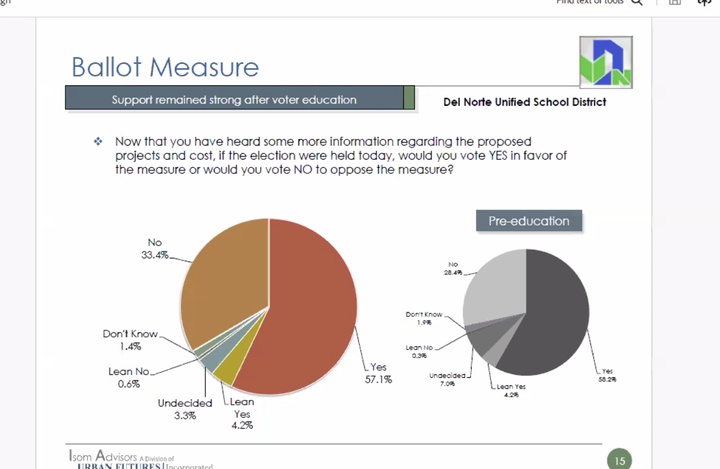Jessica Cejnar Andrews / Friday, March 15, 2024 @ 4:25 p.m. / Education, Elections
Odds Are Good That Del Norte Voters Will Support School Facilities Bond, Financial Advisor Tells Trustees

A survey conducted in January, indicated that a school facilities bond measure stands a good chance of passing in November. | Screenshot
Chances are high that voters will support a local school facilities bond measure in November, especially if those dollars will directly benefit students, a financial advisor for Del Norte Unified School District told trustees Thursday.
After his firm surveyed 359 households in January, making it clear they were voting for a property tax increase, 57 percent indicated they would approve a bond, Jon Isom of Isom Advisors said.
Noting that a bond measure needed 55 percent voter approval to be successful, Isom said those his firm surveyed supported a variety of options. This ranged from an additional cost to property owners of $60 per $100,000 of assessed value per year at the highest to the lowest option of $36 per $100,000 of assessed value per year. He did note that voters were more inclined to support the lower proposed tax rate, however.
“Our recommendation to the district would be to continue to go forward,” Isom said. “The district hasn’t in earnest had some discussions with key stakeholders, so I would definitely recommend the district do that. Those discussions should culminate with conversations with the chamber, with the business community, with teacher and staff unions, elected officials — the people that might sway public opinion.”
Noting that they would need to be as specific as possible in order to sway voters, DNUSD trustees asked administrators to bring them information regarding a five-year facilities master plan that was created about two years ago.
According to Superintendent Jeff Harris, that plan, created by former director of facilities and maintenance Steve Morgan, outlined the needed improvements by school site as well as work that had been done to pursue state funding. Those projects listed in order of priority, Harris said.
“We can also go back to the original list that was done and see which of those things have been done and which of those things in the master plan were critical when the master plan was when the master plan was issued,” he told trustees. “Some of those things are now past critical.”
The district could also use the local bond to leverage state modernization dollars from the Office of Public School Construction, Harris said. DNUSD was able to stretch the last GO bond out for several years, using those dollars as leverage for an additional $5 million to $7 million.
However, Harris noted that if voters approve another GO bond in November, stretching those dollars out for 15 years may not be wise.
“These projects need to be scheduled and done,” he said. “But if we can leverage that money in the short term, for more dollars, we could leverage $40 million into $50 million. Those are the kinds of things we really need to be thoughtful about.”
Harris promised to bring back a hard timeline along with a discussion regarding priority projects at the Board’s April 11 meeting at Smith River School.
During his presentation, Isom said voters were presented with two different versions of the survey, allowing his firm to test different bond languages and projects. Out of the 359 households surveyed, 44 percent had no ties to the district at all, he said.
Examples of potential projects that could be performed using bond dollars were also randomized. Topping the list at 80 percent support or higher were repairing and replacing leaky roofs, Isom said. There was also good support for career technical education supports, plumbing and sewer upgrades and addressing inadequate electrical systems.
Seventy percent of those who responded supported upgrades to HVAC systems along with old classrooms and restrooms. He said security improvements scored better than generic health and safety improvements.
Isom also pointed out that survey respondents were less supportive of improvements to athletic fields and facilities.
“In most communities, the voters want to pay for things that are academic,” he said. “They want to pay for things that will benefit all students. As you deviate away from the classrooms or you start to get into specific things like playfields or athletic fields — that doesn’t benefit all kids or not directly in the classroom — that’s where you start to see a little bit of erosion of support.”
In 2008, voters approved a school facilities bond that included a $52 annual property tax rate, Isom said. Those dollars paid for a new gym at Smith River School as well as renovations at Crescent Elk Middle School and Del Norte High School.
Isom noted that DNUSD could potentially benefit from a large voter turnout due to the 2024 presidential election. The ballot measure language must be finalized and submitted to the Del Norte County Elections Office by Aug. 9, Isom said.
DNUSD’s intent to pursue a bond measure comes after parents of Del Norte students participated in a news conference hosted by the non-profit civil rights law firm Public Advocates and Goodwin Procter LLP about three weeks ago.
Public Advocates is partnering with grassroots organizations like True North Organizing Network, which represents Del Norte County families, and is urging California Gov. Gavin Newsom and other officials to change the way the state distributes school modernization dollars or face a legal challenge to a public education statewide bond measure slated for the November ballot.
California’s current facilities funding mechanism often requires local school districts to pay for 40 percent of their modernization costs through general obligation bonds, Public Advocates states. This puts low-income districts at a disadvantage since their tax bases are often smaller than wealthier districts.
Low-income districts also often lack the resources to apply for grants, Public Advocates states.
CLICK TO MANAGE